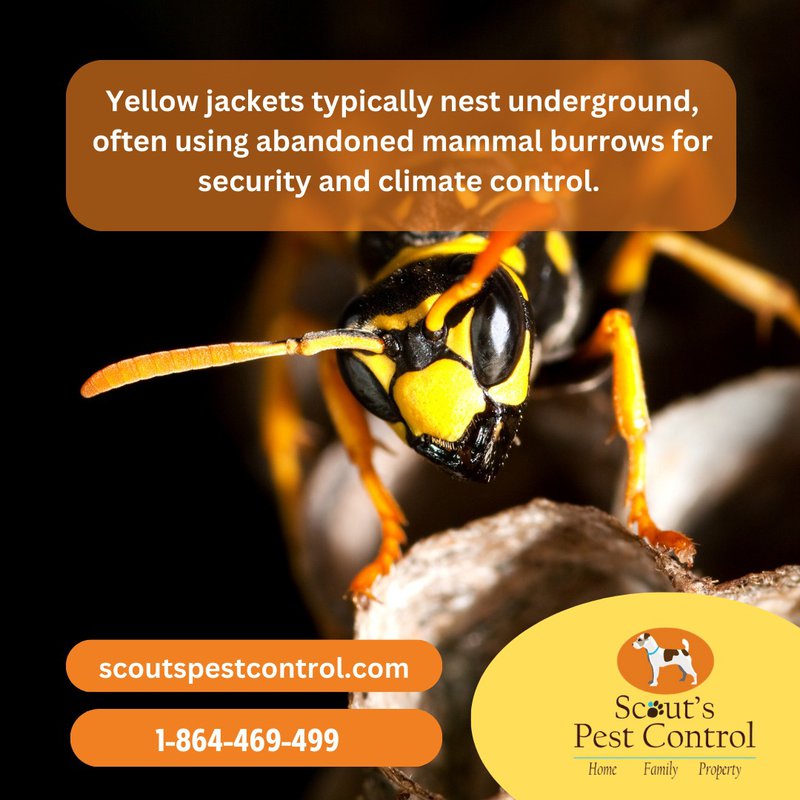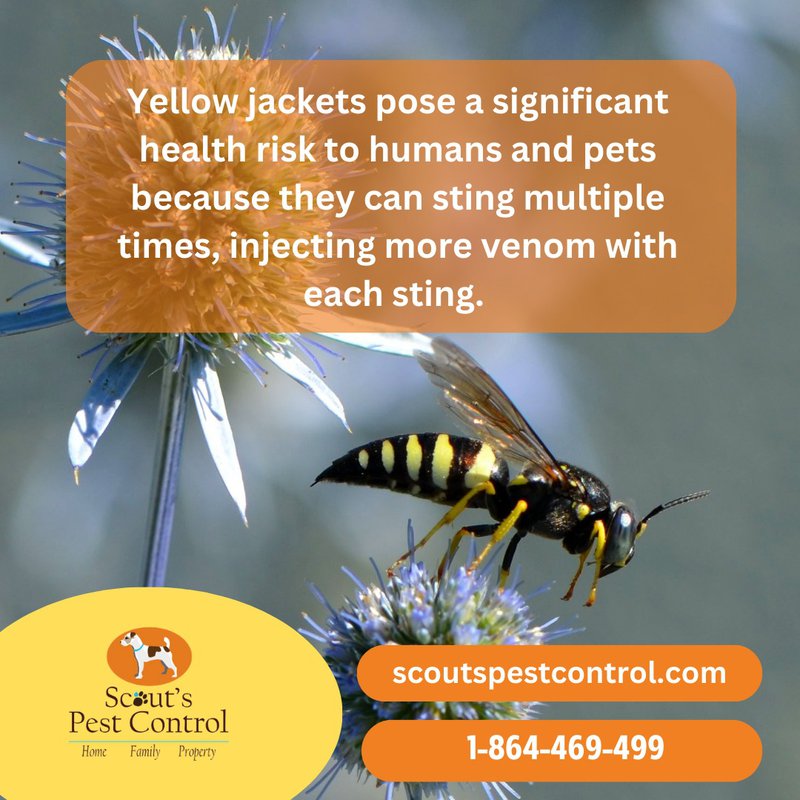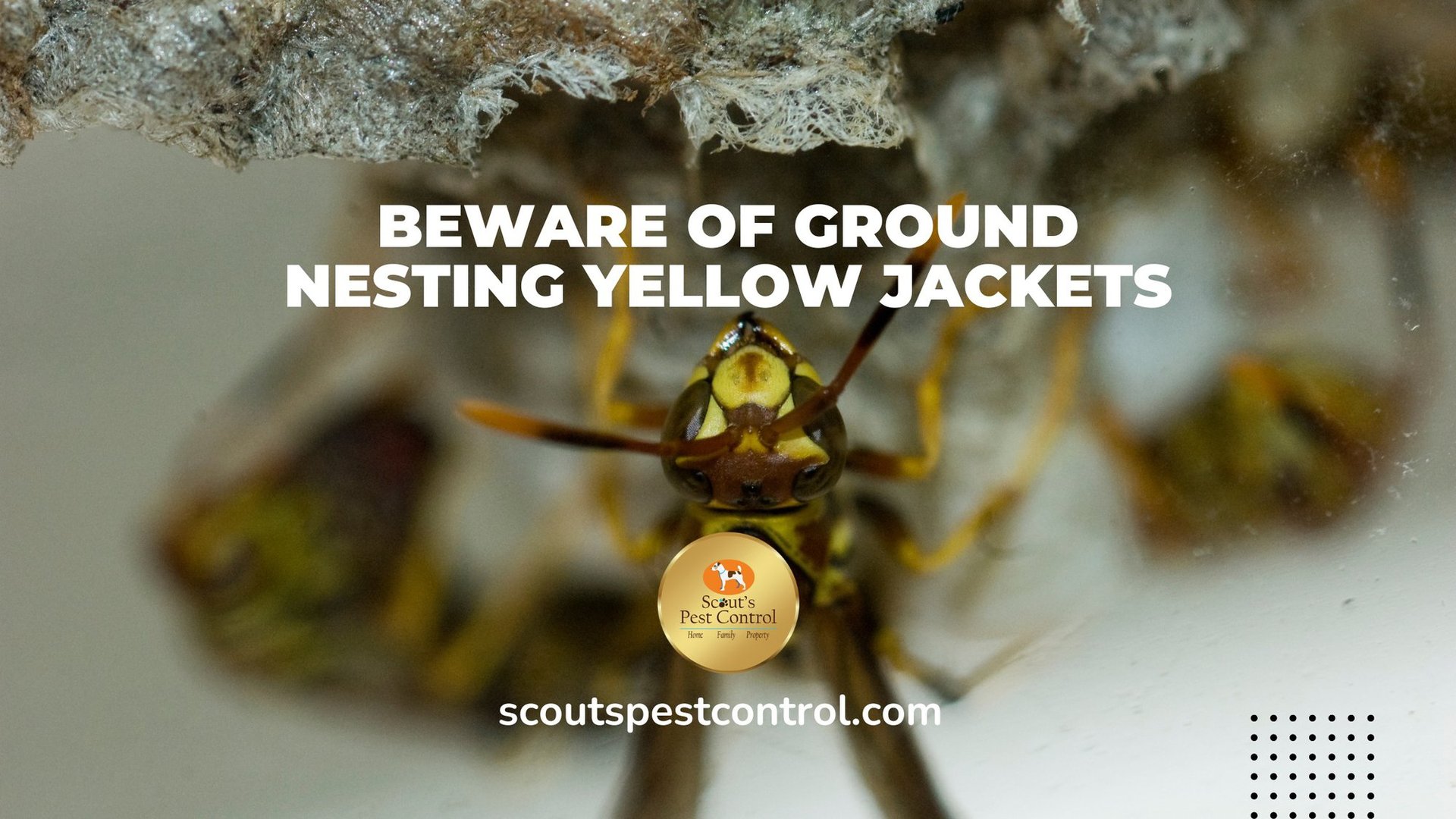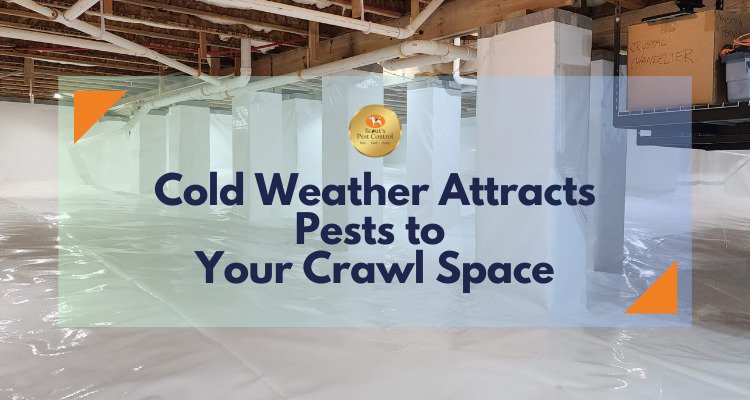The buzzing sound of yellow jackets often provokes both curiosity and concern. This highlights their dual role as vital components of ecosystems and unwelcome intruders at summer picnics. As social insects, they possess unique characteristics and behaviors that distinguish them from other insects. As a consequence, it makes understanding their ecology essential for both appreciation and management. Their presence in various environments underscores the importance of these creatures in maintaining ecological balance.
Yellow jackets thrive in diverse habitats, from intricate underground burrows to conspicuous above-ground nests. A beahvior that makes their nesting preferences rather unusual to say the least. This behavior can also be quite dangerous to pet’s and humans, but more on that later. Their construction techniques and seasonal nesting patterns showcase their resilience and resourcefulness. By delving into their dietary habits and predatory roles, we can appreciate how they contribute to ecological processes such as decomposition and population control of other insects.
However, the close encounters between ground nesting yellow jackets and humans often reveal underlying risks, including painful stings and potential allergic reactions. The aggressive nature of the Yellow Jacket is unique in terms of the capacity to sting and its relentless pursuit of what they consider a danger to the nest, the queen and the young. Let’s dive into the ecology of yellow jackets, focusing on their nesting behaviors, impact on ecosystems, interactions with humans, and strategies for coexistence.
Identification of Yellow Jackets

Yellow jackets are highly recognizable stinging insects commonly found across North America, known for their distinctive appearance and sociable behavior. A mature yellow jacket averages between 3/8 to 5/8 inches in size and boasts a characteristic bright black and yellow striped pattern. One of the key features setting them apart from similar insects is their yellow and black head combined with a narrow waist, giving them a wasp-like look. Their bodies are sleek with six hairless legs, while their abdominal pattern consists of black and yellow bands, which are uniquely informative to entomologists studying these social wasps.
Habitat Preferences

Yellow jackets are highly adaptable in selecting nesting sites, ranging from underground cavities like abandoned rodent burrows to exposed areas such as eaves and attics. They prefer concealed spots for protection and insulation but will nest in more open locations if needed. Signs of an underground nest include small piles of dirt and stones around a burrow entrance. These social wasps are very defensive, housing thousands and becoming particularly aggressive in late summer. You will often mistake a yellow jacket nest in the ground for some other animal that may provoke curiosity, but that is highly dangerous. Often, children and pets will stumble on a yellow jacket nest by accident and that can provoke a response, more on that later.
Their distinctive side-to-side flight pattern upon landing signals their readiness to defend their nest against intruders.
Ground Nesting Yellow Jackets Nest Behavior
Yellow jackets typically nest underground, often using abandoned mammal burrows for security and climate control. The small, nickel-sized entrance to their nest is hard to spot, helping it remain hidden from predators and humans. Inside, they build a paper-like structure from chewed wood and saliva, creating brood cells for their young. By summer's peak, the nest can host several hundred worker wasps, who vigorously defend their underground home.

Above-Ground Nesting Sites
Some yellow jackets establish nests in above-ground sites, such as human-made structures or natural settings like shrubs and under eaves. Their versatile building materials allow them to attach nests to structures or burrow through construction materials. These nests can grow significantly, housing up to several thousand yellow jacket’s. Like underground nests, above-ground yellow jacket nests are fiercely defended by worker wasps. Signs of these nests include a steady flow of insects entering and exiting a spot and disoriented worker wasps nearby.
Yellow Jackets Ground Nesting Behaviors
Yellow jackets exhibit distinct nesting behaviors crucial for their colonies' survival. Preferring underground or concealed areas, they often nest in gardens, near tree trunks, or abandoned rodent burrows. In spring, the queen emerges from hibernation to find a defensible nesting site near food sources. She starts building a small, papery nest from chewed wood fibers, where she lays her first eggs.
As the colony expands, the queen focuses on reproduction while sterile female workers take over nest maintenance and expansion. They add more paper cells for the queen to lay additional eggs, rapidly growing the nest into a large underground fortress housing thousands of wasps ready to protect and maintain their home.
Seasonal Changes in Nesting Patterns
Yellow jackets' nesting patterns follow a seasonal cycle. In spring, overwintered queens emerge to start new colonies, initially hunting insects for protein to feed their larvae. As these larvae develop into adult workers, they take over foraging and nest maintenance, allowing the colony to grow.
By late summer, the diet of yellow jackets shifts from protein to sugary foods due to decreased insect prey, often leading to increased human encounters. The colony's focus shifts to raising new queens who will overwinter and establish colonies the next year. As fall arrives, nests reach their peak size, sometimes housing thousands of wasps. With the onset of cold weather, most workers and the founding queen die, leaving only the young queens to survive the winter and continue the cycle in spring.

Life Cycle of Yellow Jackets
Yellow jackets' life cycle begins in spring when overwintered queens emerge to establish new colonies in soil cavities or repurposed rodent structures. They build small paper nests from wood fibers and saliva, laying eggs that hatch into workers who take over nest expansion and foraging. By August, colonies can reach several hundred workers. As autumn approaches and food sources dwindle, new queens are produced and mate, preparing to overwinter. The temperatures drop, and the original queen and workers die off, leaving only the new queens to start the cycle again in the following spring.

Risks to Humans and Pets
As we mentioned previously, Yellow jackets pose a significant health risk to humans and pets because they can sting multiple times, injecting more venom with each sting. This is especially dangerous for allergic individuals, who may experience severe reactions like anaphylactic shock. Even non-allergic people can suffer severe reactions from multiple stings, sending over 500,000 people to the emergency room annually. By late summer, yellow jacket colonies can grow to house thousands of defensive workers, increasing the risk of attacks. Noise and vibrations from lawn mowers, trimmers, and other equipment can provoke these insects, as can pets' curiosity, leading them too close to nests and triggering aggressive responses. It is important that if you spot nesting behavior, contact Scouts Pest Control immediately to protect your family and pets from these dangerous insects.

Management and Control Strategies
Effective management of ground nesting yellow jackets or above ground nesting requires targeted approaches, especially during warmer months when these stinging insects are active. Aerosol insecticides labeled for yellow jacket control can be applied safely from a distance, and boiling water at night can effectively target nests when the insects are less active. However, it is always better to have professionals like Scouts deal with this as DIY strategies can cause more issues.
Yellow jackets are attracted to protein-rich foods. Luring them away with tuna or chicken placed at a safe distance can help keep them away from human activities. However, care must be taken not to attract them closer to living spaces.
Applying insecticides in the late evening or at night ensures foragers are inside the nest, reducing defensive responses. Protective clothing, such as long sleeves, gloves, goggles, and dust masks, is essential during treatment.
Yellow jackets are most aggressive in late summer, defending their colonies instinctively. Recognizing this behavior helps in planning effective control strategies.
Trapping Methods
Trapping methods offer an additional or alternative strategy for managing localized yellow jacket populations. Lure traps, which use chemical attractants can reduce yellow jacket presence in specific areas. Although not effective for large populations, they can alleviate issues caused by these stinging insects. Another tip is adding meat to lure traps as this can significantly increase their efficacy. Homemade traps using raw fish or liver suspended above soapy water can also attract and drown yellow jackets. However, when dealing with Yellow Jacket’s it is better to turn this over to pest professionals.
A downside of traps is they require regular maintenance, including monitoring, cleaning, and bait replacement, to remain effective. Care must be taken to avoid unintentionally attracting beneficial insects, such as honey bees. An alternative, less intrusive technique is bee lining, where the behavior of foraging workers is observed to locate their nests. By following yellow jackets as they return from food gathering, it is possible to identify nest entrances, aiding control efforts.
Chemical Control Options
Chemical control of yellow jackets involves using insecticides applied late in the evening or at night when activity is lowest and most foragers are in the nest. Quick knockdown insecticides are preferred for immediate results and to reduce aggressive responses. Pesticide dusts are more efficient than sprays, as they stick to the insects and are carried into the nest, increasing the chance of reaching the queen and other colony members.
For difficult-to-access nests, cold weather can naturally eliminate yellow jacket colonies, as they typically don't survive winter. Non-toxic methods include spraying with soapy water or using homemade traps like inverted soda bottles filled with sweet attractants to catch the insects without harmful chemicals.
Best Practices for Coexistence

Yellow jackets often build their nests near human activity, leading to potential conflicts, especially outdoors. Understanding their behavior can enable peaceful coexistence. If a nest is away from high-traffic areas, it can be left undisturbed. To avoid attracting yellow jackets, avoid wearing bright colors or sweet perfumes, which they may mistake for floral food sources. Increased activity in early spring might indicate a small, manageable nest. When encountering yellow jackets, remain calm and avoid swatting, as alarm pheromones can trigger aggression. Marking a safety perimeter around a nest with tape or spray paint can help maintain a safe distance until the colony naturally dies off in colder weather.
Safe Outdoor Event Planning
Outdoor events can attract yellow jackets, particularly if food sources are involved. Consider wearing a veil and hat as protective gear, and keep a pressurized container of wasp or hornet spray on hand to defend against potential yellow jacket stings. If a sting does occur, calmly move away from the area—erratic movements can attract more yellow jackets. For individuals with heightened sensitivity to bee stings, carrying a sting treatment kit is essential during outdoor activities. Additionally, distancing food sources such as cans of tuna or chicken away from gathering areas can help draw yellow jackets elsewhere, reducing their presence at the event.
Residential Guidelines for Yellow Jacket Management

For homeowners, understanding that yellow jacket colonies typically do not survive the winter can inform how to handle a discovered nest. If the nest is not in a commonly used area, it may be left alone to die off during a hard freeze. However, for active nest management, wearing protective clothing is paramount and its best left to a professional. Closing off access to underground nests and using a pyrethrum-based insecticide can be effective, yet serious infestations may require professional help from pest control professionals. To prevent attracting yellow jackets, keep pet food and sweetened beverages indoors, and consider setting up yellow jacket traps in the spring or early summer when the colony size is modest. As the season progresses, these traps around seating areas can deter yellow jackets from becoming uninvited guests at your outdoor gatherings.
Final Thoughts: Balancing Ecological Importance and Public Safety
Yellow jackets, while often perceived as aggressive stinging insects, have a notable role in our ecosystem. Their activities as predators help manage pest populations and they also contribute to pollination. However, the risk to public safety cannot be overlooked, especially considering the large size colonies can reach by late summer, with some containing thousands to over 100,000 individuals in warmer regions. Remember there are two ways to identify the nests. There are ground nesting yellow jackets that nest in holes in the ground. Particularly abondoned burrows or you have the above ground nests typically in trees and attached to structures such as residential homes.
To coexist safely with these social wasps and minimize the risk of stinging incidents, it is vital to take preventative measures. Avoiding bright colors and floral scents can reduce attraction, and being cautious not to provoke them is key—swatting can lead to pheromone release, which incites attack. Given the over 500,000 emergency room visits annually due to stinging insects, awareness and precaution during outdoor activities are imperative.
In essence, it's about finding a balance between appreciating the ecological contributions of yellow jackets and exercising caution to protect human health. Taking simple steps to avoid attracting these insects can significantly reduce the chances of unpleasant encounters, allowing us to enjoy our outdoor experiences while respecting the natural habitats of these complex creatures.
If you spot a yellow jacket nest in your yard or garden, then be wise. Ground nesting yellow jackets are often mis identified. Call Scout’s Pest Control as we have the knowledge and the skills to erradicate these Pests.





